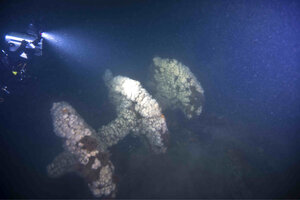Anonymous New Jersey wreck identified as pre-Civil War ship
The once mysterious ruined ship has been identified as the Robert J. Walker, a steamer ship that belonged to the U.S. Coast Survey and that sank in a tragic accident 153 years ago.

A once anonymous shipwreck ship has been identified as the Robert J. Walker, a steamer ship that belonged to the U.S. Coast Survey and that sank in a tragic accident 153 years ago.
NOAA
For years, a jumble of wreckage on the New Jersey coast had been anonymous. Since 1970, when a commercial fisherman found the ruined ship 85 feet underwater, recreational divers had visited it, exploring its engines, its paddle wheels, and its portholes. Still, no one knew what ship this was.
Now, the ship has been identified as the Robert J. Walker, a steamer ship that belonged to the US Coast Survey and that sank 153 years ago, just before the Civil War.
In 1807, President Thomas Jefferson founded the US Coast Survey, the predecessor to the National Oceanic and Atmospheric Administration (NOAA), and charged it with mapping the young country’s recently won coasts. Around 1860, as the US brimmed with stirrings of war, those efforts were redoubled; charting the eastern coasts would be critical to the North’s success, the government expected.
The Walker was one of the survey ships deployed to map the Gulf Coast and to help the North create a portrait of the American coastline, which would soon be plotted with bases and strategic landing points.
But on June 21, 1860, The Robert J. Walker was en route back to New York from the Gulf of Mexico, where it had been mapping. It was just ten miles from arrival, plugging along the Absecon Inlet, near the New Jersey coast, when a commercial schooner rammed into it.
“As both vessels were under full headway, there was no time for either to alter his course, and the shock was instantaneous and terrible,” reported The New York Times, at the time.
The seas were rough, and “there was no time to be lost”: the Walker “was fast sinking,” the Times said. Hammocks were stuffed into the gaps in ship’s side, to plug the leaks. Lifeboats were hauled up, and a sick sailor and a woman passenger were ushered in. “The next moment she went down, carrying with her all who were on her decks,” the Times reported.
The accident killed 20 of its 66 crewmen in just 30 minutes and was the largest single loss of life in the history of NOAA or any of its predecessor agencies.
This summer, a NOAA Maritime Heritage diving team, on a separate Hurricane Sandy-related mission in the area, identified the Walker after noting that its features matched key components of the long sunk ship. The wrecked ship, the team found, was still pointing toward the Absecon lighthouse, the guiding light it had been following when it went down.

